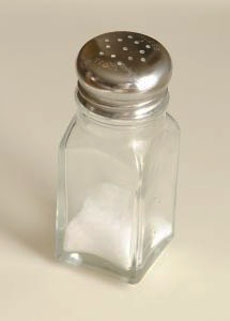TIP OF THE DAY: Salt Alert ~ Read The Labels

This is not your friend. Photo by Ramon |
Salt (sodium chloride) helps prevent food spoilage by drawing out moisture, where bacteria grow and kills existing bacteria that might cause spoiling.
Salt also helps to disguise metallic or chemical aftertastes and provides a recognizable flavor when other ingredients fail to (the next time you bite into a potato chip or tortilla chip, consider how much of what you taste is potato or corn, versus salt). At one time, salting was one of the only ways to preserve food. Yet salt remains a prominent ingredient in many processed foods. Even though we now know that too much salt is not healthy, some servings of processed food contain a day’s recommended salt allowance. Salt raises blood pressure. The higher your blood pressure, the higher the risk for heart disease and stroke. Only hypochondriacs walk around worrying that they’ll have a heart attack or a stroke. But consider all of the people you’ve known: The risk is real for many people. |
|
| By reading the labels on what you eat, you can limit your salt intake. The USDA suggests a limit of 2,300 mg or less salt per day—one teaspoon!—for healthy adults under 50, and 1,500 mg for those over 50, those with certain health issues and African-Americans.
These latter groups, who should consume no more than 1,500 mg of sodium a day, comprises 2/3 of adults. Yet the average American consumes 4,000 mg of sodium a day—most of it hidden in processed foods. Tips from the Mayo Clinic & THE NIBBLE To Reduce Salt In Your Diet
If you’re young and healthy, you may not think you have to worry about what you eat. If you’re older, it’s hard to change habits. But don’t think of salt as a treat. Think of it as lard: It may taste good, but there are other options that taste just as good, and are much better for you. All you have to do is make the switch.
|
||


